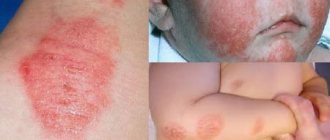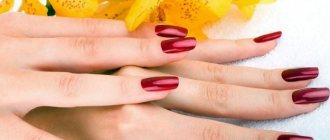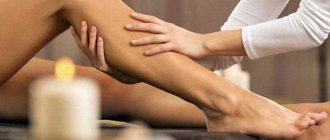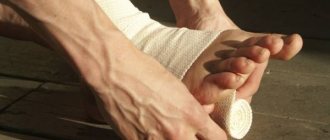Thickening of the nails, changes in shade, deformation and detachment of the plate from the nail bed signal a serious malfunction in the body. If you do not find out the cause of the disease in time and do not start treatment, then there is a risk of worsening the situation. We are talking about a disease such as nail onycholysis, which is infectious or fungal in nature. First of all, it causes psychological discomfort (especially for women), because you can immediately forget about the beauty of your hands and feet. As a rule, no pain or itching is observed; this is possible only when a secondary infection occurs.
Danger of illness
This disease does not pose a threat to human life, but it still needs to be treated. Firstly, affected nails look unsightly and repel others. In women, this problem can provoke the development of complexes. Secondly, infection may occur and the condition may worsen: suppuration, rejection of the plate and complete cessation of nail growth.
If onycholysis appears after an injury or as a result of non-infectious diseases, then it is not contagious and is not transmitted to others. Fungal or bacterial infection is dangerous for others.
Nail peeling
General information
Onycholysis is the distal separation of the nail plate from the bed. The pathological process occurs on one finger of the hands or feet or affects several fingers at once. In 60% of cases, onycholysis is a consequence of traumatic injury, in 30% it develops as a result of chronic dermatomycosis, the remaining 10% are systemic somatic diseases, dermatoses and pyoderma. Onycholysis can occur at any age; it is more often diagnosed in women, which is associated with professional nail care. It has no racial or seasonal differences and is not endemic. The disease was first described by Geller in 1910. The relevance of the problem is determined by the aesthetic component, which negatively affects the patient’s quality of life.
Signs of illness
The disease can most often be noticed by the emptiness under the nail. It starts from the free edge and reaches halfway; in rare cases, the plate is completely torn off. The surface remains shiny and smooth, the shade can be gray or light yellow, as seen in the photo. Deformation, delamination, porosity indicate a fungal or bacterial infection. So, you need to see a doctor if you have at least one symptom:
- void under the plate;
- discoloration of the nail to yellow or gray (after a blow it may turn dark red and then turn black);
- thickening and coarsening of the lateral ridges or cuticle;
- itching, burning, pain due to mechanical impact;
- deformation of nails (bumps, change in shape).
Hands are more often damaged due to improper care and manicure. An allergic reaction to gel polish is accompanied by a burning sensation of the skin around the nail bed. Onycholysis of toenails appears after wearing tight shoes. In this case, the disease affects only the thumbs or little fingers.
Classification
To prescribe adequate therapy, taking into account the heterogeneity of the pathology, several types of onycholysis are distinguished in dermatology:
- Traumatic - occurs as a result of damage to the nail or subungual space due to wounds, burns, splinters, chemical or physical influences, prolonged exposure to water or wearing tight shoes.
- Dermatological - is a consequence of long-term dermatoses with impaired trophism in the affected area.
- Endocrine – formed against the background of endocrine disorders and humoral disorders.
- Systemic – develops with systemic pathology of the digestive tract and metabolic disorders.
- Fungal - is the result of the formation of colonies of microbes in the subungual space with changes in the nail bed while maintaining a normal nail. It can be the result of a long-term mycotic infection with damage to the nail plate and the formation of foci of secondary onycholysis.
- Bacterial – occurs when a secondary infection occurs.
- Allergic - develops against the background of taking medications with photosensitizing properties, contact with chemicals, and ultraviolet radiation.
Diagnostics
It is not always possible to identify the visible cause of the disease on your own; in any case, it is recommended to consult a doctor. You should make an appointment with a dermatologist and undergo the necessary examination. With the help of laboratory tests, it is possible to identify the pathogen and its resistance to drugs. Only after this the specialist will be able to tell how to treat onycholysis.
A scraping will be taken from the affected areas, then the material will be sent to the laboratory. A general blood and urine test will help the doctor determine the patient’s health status, and then select appropriate medications for local or internal use. If it was not possible to identify the cause and make a diagnosis, then you will need to visit other specialists: an endocrinologist, a neurologist, a gastroenterologist.
How to cure the disease
The treatment regimen depends on the cause of onycholysis, which is why it is so important to find out. For infectious diseases, antimycotic, anti-inflammatory and antiviral agents are prescribed. They are available in the form of creams, solutions, gels or tablets. It is recommended to drink a vitamin complex simultaneously with drug therapy: vitamins A, B, C, calcium and iron.
In some cases, injured nails are removed if inflammation is observed. After surgery, bandages should be changed regularly and fingers should be treated with an antiseptic. In most cases, it is enough to properly care for the damaged plate yourself. It must be carefully cut with scissors until the old nail is completely replaced by a healthy one. Many doctors advise covering the affected areas with an antibacterial bandage, otherwise you can accidentally tear off the plates and cause an infection.
How to cure an illness after long-term use of antibiotics or other drugs? We must focus all our efforts on strengthening the immune system; it is not necessary to use medications. For this purpose, vitamins or immunomodulators, as well as probiotics, are used. Attention should also be paid to nutrition, because constant strict diets negatively affect the gastrointestinal tract and the general condition of the body.
Sakania Luiza Ruslanovna
Dermatovenerologist, cosmetologist, trichologist
Ask a Question
It is possible to cure onycholysis caused by a fungal infection only with special means. You cannot use them on your own, since each medication has a number of contraindications and side effects. The advanced form requires complex therapy, including treating the affected fingers with ointments or solutions and taking internal medications against the fungus. They use drugs such as Exoderil, Amorolfine, Ketoconazole, Fluconazole, Ciclopirox. On average, the course lasts from 2 weeks to 2.5–3 months.
Apply varnishes, ointments or creams only to the prepared nail plate. Usually it is removed completely or partially using a special device. At home, it is recommended to steam the nails, cut off detachments and treat the sore spot. After treatment, you should continue to use the drug for some time to avoid relapse. Often the main medication is replaced with another one that is more suitable for preventing fungus.
How else can you get rid of onycholysis of fingernails at home? It will be useful to make baths with medicinal herbs and available products. For example, the simplest folk recipe is to mix sea salt with warm water (1.5 tablespoons per 1 liter) and keep your hands in the solution for 15–20 minutes. Repeat the procedure 3-4 times a week. Natural medicines include a decoction of pine branches, chamomile, calendula, St. John's wort, nettle, and celandine.
During therapy, you should stop using nail polish and try not to apply cream to the plates. Some women share bad advice on forums to hide the defect for a while. For example, do nail extensions or paint over with dark gel polish. Under no circumstances should you do this, otherwise infection or severe inflammation may develop. It is better to cut off the damaged nail and seal it after applying the drugs with a flesh-colored bactericidal patch. When cleaning or working with aggressive substances, only wear rubber gloves.
Onycholysis: treatment at home with folk remedies – Nail info
There are not many diseases associated with nail damage.
Onycholysis stands apart - a disease, the progression of which leads to the separation of the horny plate from the nail bed. This is accompanied by obvious external manifestations: changes in the color and structure of the nail. In some cases, the disease spreads to only one finger, in others it affects several. Onycholysis treatment with folk remedies
Causes of the disease
There are many different factors that provoke the development of onycholysis, but the most common cause is injury to the nail plate. Most often this occurs due to such damage:
- severe bruise of the phalanx;
- subungual hematoma;
- burn;
- “tearing off” the nail, etc.
Numerous infectious diseases that are of fungal origin also lead to the appearance of onycholysis. However, this does not exclude the possibility of bacterial infection, since such precedents are already known to medicine. Sometimes the development of the disease is accompanied by severe and painful inflammation.
Onycholysis
Quite rare, but still real sources of onycholysis are heterogeneous allergens. Let's explain with an example: if you paint your nails for a long time with a varnish that contains an irritating element, the result can be an unpleasant illness. It is important to understand: this is only possible under conditions of frequent contact with the allergen.
There are a number of diseases that can become the basis for onycholysis. Among other things, psoriasis, vascular and neurological diseases, eczema and endocrine disorders can be noted.
Clinical signs of onycholysis
Clinical signs of onycholysis
This disease manifests itself with very clear and obvious symptoms that are difficult to miss in everyday life. First of all, onycholysis is expressed in a change in the color of the nail plate. Some of the most common colors that nails take on include white, yellow and blue.
If the disease is the result of an injury, the skin under the nail will have a purple tint. Another symptom of onycholysis is a change in the border line that separates the two parts of the nail: white and pink. As the disease progresses, it becomes uneven.
In addition, the shape of the nail itself changes due to thickening of the skin under the horny plate.
Course of the disease
In most cases, the disease does not cause any particular discomfort to its carrier. This is due to the fact that it develops without significant pain. However, a secondary infection can cause acute throbbing pain, which most often prompts the patient to consult a specialist.
Course of the disease
Onycholysis is divided into two types: complete or partial. The very name of the varieties indicates the degree of damage to the nail plate.
Treatment of the disease
The fight against the disease most often takes a lot of time and consists of finding and eliminating the sources that provoke onycholysis and ensure its further development. If you carry out treatment without taking these factors into account, the effect will be insignificant, and the symptoms will remind you of themselves at regular intervals.
The easiest to treat is onycholysis, which is the result of trauma to the nail plate. This is one of the few cases when a diagnosis can be made without the help of specialists. Other situations require a thorough examination and the development of an individual treatment package.
ethnoscience
It is effective to turn to folk experience, which offers several effective ways to combat the disease. It is important to understand that the success of the procedures largely depends on their regularity, since a one-time or illiterate execution of the selected actions will not bring the desired result.
Nail baths
Nail baths
For the treatment of onycholysis, baths prepared using a small amount of sea salt are very useful. It is recommended to carry out this procedure at least twice a day for three months.
If necessary, the period can be extended.
Traditional healers insist that sea salt, which happens to be the main component of the medicine, should not contain any additives, as they may be harmful to the infected area.
Healing rubbing
The rapid restoration of nails is facilitated by the use of olive and sea buckthorn oil.
Sea buckthorn oil
The scheme for using the substance is simple - you should take a small amount of the selected oil, rub it into the periungual area and apply it to the nail plate.
It is best to do this before going to bed, since after the procedure it is recommended to wear gloves made of cotton fabric on your hands, and in everyday activities this may cause some discomfort.
Sometimes the oil is mixed with a few drops of lemon juice, which also has a beneficial effect on the condition of the nails.
Compresses against onycholysis
In order to cope with the disease and restore the damaged nail plate, you can use alum compresses.
Alum
You need to take five grams of the substance, combine it with twenty-five milliliters of glycerin and add fifty milliliters of water. All ingredients are thoroughly mixed and used as a basis for compresses.
Take a small piece of bandage, soak it in the composition, fold it several times and apply it to the nail. The compress is secured on top with cling film and a bandage. It is best to do such procedures before going to bed.
Vitamin baths
Vitamin baths
To prepare an effective product, the following components are required:
- pine needles - 1 tbsp. spoon;
- dry chamomile – 1 tbsp. spoon.
The plants should be chopped and poured with one glass of boiling water. Before proceeding to the next step, you should wait until the solution has cooled. The cooled medicine is filtered using gauze and mixed with green tea. You need to dip your fingers into this mixture and keep them there for half an hour. It is recommended to perform the procedures daily.
Gelatin
Treatment of onycholysis is not complete without the use of gelatin. Effective baths are made from this substance.
Baths with gelatin
You should take one spoon of gelatin and a glass of water. The ingredients are combined and left for thirty minutes. After this, the mixture should be heated over low heat until the gelatin is completely dissolved in the water.
The solution should be cooled before use, otherwise there is a risk of burning your fingers. The medicine is poured into a convenient container where you can place your fingers with damaged nail plates.
The duration of the procedure is fifteen minutes.
Treatment with vinegar
In order to get rid of all signs of the disease as soon as possible, you need to use such a simple ingredient as a bite. It is recommended to use apple cider vinegar as the main ingredient, but any other variety can be used as an alternative.
Treatment with vinegar
You should pour the liquid into a basin or other convenient container, after mixing it in equal proportions with water. It is necessary to immerse your hands in the prepared solution for twenty minutes, and after the procedure, wipe them with a dry towel. To achieve the effect, you should carry out the procedure at least twice a day.
Treat with medical alcohol
Rubbing alcohol is a medicine that can be purchased at any pharmacy without providing a prescription. The method of using it is extremely simple: pour alcohol into a deep plate and put your hands in it for twenty minutes. This is done twice a day: morning and evening.
Hydrogen peroxide vs onycholysis
Hydrogen peroxide against onycholysis
You should purchase hydrogen peroxide and immerse the affected nail in it. The duration of the procedure is from fifteen to twenty minutes. Frequency: twice a day.
You need to focus on your feelings: some people complain of discomfort caused by too high a concentration of peroxide.
In such cases, it should be diluted with a small amount of water until comfortable conditions are achieved.
Grapefruit
Grapefruit Seed Extract
To treat onycholysis, grapefruit seeds, or rather their extract, are used. You should take a small amount of extract, mix it with water and bring to a homogeneous consistency.
The resulting composition should be applied to the cuticle area and the front of the nail plate. The mixture should be kept for ten minutes and then washed off with warm water.
The procedure is carried out twice a day until the symptoms of the disease completely disappear.
Source:
Onycholysis - treatment with folk remedies - Methods and means of treating diseases
The disease can appear on the arms and legs and affects both men and women.
What are the reasons for its appearance, how is onycholysis treated at home, what should be done to prevent this problem from occurring? These exciting questions will be addressed today.
Reasons for appearance
Various infectious and non-infectious factors can trigger the onset of the disease. The main infectious cause of nail detachment in 70% of cases is nail fungus.
Less commonly, the disease begins due to a bacterial infection - streptococci and staphylococci.
Among the non-infectious causes of onycholysis are the following:
- frequent use of antibiotics;
- dermatological problems – psoriasis, eczema, dermatitis;
- avitaminosis;
- diseases of the nervous, digestive, endocrine, cardiovascular systems. Due to malfunctions in the body, the nail plate does not receive enough nutrients, as a result of which the destructive process of the nail begins;
- use of low-quality nail polishes;
- frequent contacts with household chemicals - powder, liquids for washing dishes, floors, etc.;
- nail injuries.
Is onycholysis contagious?
The defect itself is not contagious. But if it is caused by a fungal or bacterial infection, then the problem can spread from person to person.
It turns out that the disease that caused the nails to peel off is contagious.
Symptoms of onycholysis
The main indicator by which one can judge the presence of the disease is the detachment of the edge of the nail plate . Subsequently, this process can go deeper and even affect the area of the hole, that is, the person faces complete loss of the nail.
Regarding other symptoms of the disease, they differ depending on the causes of onycholysis. So, the main symptoms may include:
- unevenness, thickening of the nail plate;
- change in nail color;
- pain, redness, swelling, suppuration - these symptoms are characteristic of the infectious nature of the disease;
- brittleness of nails, the appearance of small pinpoint depressions on them;
- hematomas, bleeding from under the nail - due to mechanical injuries.
Differences between onycholysis and fungus
Some people may mistakenly confuse these diseases. Onycholysis and fungus still have significant differences:
- Non-infectious onychodystrophy is not contagious, but onychomycosis (nail fungus) is always contagious.
- The first and obvious symptom of onycholysis is nail detachment and thinning. While the fungus is characterized by a change in color, as well as thickening of the nail plate, its keratinization.
- The fungus always causes itching, burning, redness, but onycholysis does not.
- Onychomycosis is characterized by an unpleasant odor of the feet, but with onychodystrophy of a non-infectious nature it is not.
- Onychomycosis is always caused by a fungal infection. While onycholysis can also appear as a result of injuries, malfunctions in the functioning of various body systems.
But there are often situations when these diseases are intertwined, that is, a fungal infection can be connected to onycholysis. And then only a doctor can determine the nature of the disease based on tests.
Which doctor should I contact?
If the doctor suspects that the cause of onychodystrophy is an infection or bacteria, then he must make sure of this. To do this, the doctor takes a scraping from the surface of the affected plate and sends the material to the laboratory.
Source: https://xn--80adxbwkcj6a4cc.xn--p1ai/uhod-za-nogtyami/oniholizis-lechenie-v-domashnih-usloviyah-narodnymi-sredstvami.html
Prognosis and prevention
Prevention
Timely therapy under the supervision of a specialist guarantees a good effect. You should not expect quick results, since treatment almost always takes several weeks. According to various reviews from recovered people, it takes 3 to 5 months for healthy nail plates to grow. You can speed this up by doing self-massage and baths with herbal infusions. Without seeing a doctor and using medications, the prognosis is poor. Nails can grow back deformed, change color and cause discomfort. With an infectious lesion, the disease eventually spreads to all fingers.
To reduce the risk of relapse, it is necessary to properly care for your hands and feet. Observe personal hygiene rules and use only high-quality nail products. When working with harmful substances, you must use gloves. Proper nutrition, regular intake of vitamins and a healthy lifestyle will help avoid recurrence of the disease. Having identified the symptoms of the pathology, you should contact a dermatologist and find out the cause of the disease.
Many people do not pay attention to the condition of their nails, but in vain. Sometimes a change in the shape or color of the plate is a signal of a malfunction in the body. Onycholysis can be quickly cured at home if the problem is noticed in time. If the form is advanced, the plates will need to be removed, followed by a long rehabilitation period.
You can ask your question to our author:
Tactics for onycholysis. Which doctor treats onycholysis?
In order for the treatment of onycholysis to be successful, problems with the stomach, heart, thyroid gland, etc., which could provoke detachment of the nail plate, should be identified and eliminated.
Knowing about this relationship, a competent dermatologist does not ask the question of how to cure exfoliation on the arms or legs - he will definitely send the patient to specialized specialists who will examine him and prescribe treatment.
Whatever the reason for the detachment of the nail plate, in any of the cases a course of general restoratives is prescribed:
- vitamins (primarily A and group B);
- iron supplements;
- calcium both in the form of pharmaceuticals and in food (cottage cheese, milk).











